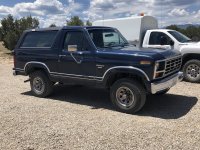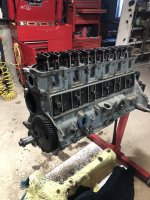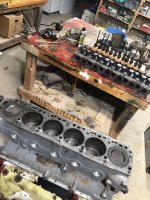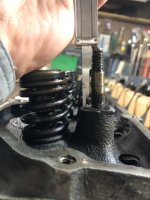So I’m beginning to amass knowledge and parts for my project. I have a 1985 bronco. It currently has the original 5.0 and AOD tranny. I wish to build a boosted EFI 300. I want the rpm range to top out at about 4K. I purchased a parts truck for my son (82 f150) that has a good 300 in it. I also have a complete 300 from a 95 van that I’d like to use the intakes, front cover and serpentine set up from as well as any other sensors or other parts needed for EFI. I am thinking Holley or mega squirt for the engine management not sure yet there. I haven’t decided what transmission to use yet. Maybe the AOD. I have a NP435/Dana 20 setup I was thinking of using along with a torque splitter. I will be replacing both axles with 06 super duty style or if I can find a front Dana 44 from a 78-79 Ford.
I’m looking to build a reliable truck that’s at home on and off pavement and maybe do some light towing. From what I’ve been reading on the forums 10 lbs of boost seems to be my target. I don’t have unlimited funds but I will spend money to do it right. I would like to do as much of the work as possible as my skills will allow. I have some good experience mechanically and also really want to learn through the whole process. My 16 year old son will be learning along with me as he has a bullnose f150 he is putting together we’re doin the Offy/Sniper route there.
I have read tons on these forums and learned so much from a couple of gents. Thanks for this! I’m hoping to get input on my direction here and also help filling in the gaps. Any suggestions/questions are very welcome. That’s exactly why I’m here. You guys rock. I want a clear path to completion before I get knee deep into this.
My first step here is to get the 300 from the 82
On the stand and look it over then I’ll be asking for input as to what to tell the machine shop. Next in mind I’m thinking what Turbo setup will be best. I’ve bought a couple books you guys have mentioned. Light reading while I’m in the house!
I’m looking to build a reliable truck that’s at home on and off pavement and maybe do some light towing. From what I’ve been reading on the forums 10 lbs of boost seems to be my target. I don’t have unlimited funds but I will spend money to do it right. I would like to do as much of the work as possible as my skills will allow. I have some good experience mechanically and also really want to learn through the whole process. My 16 year old son will be learning along with me as he has a bullnose f150 he is putting together we’re doin the Offy/Sniper route there.
I have read tons on these forums and learned so much from a couple of gents. Thanks for this! I’m hoping to get input on my direction here and also help filling in the gaps. Any suggestions/questions are very welcome. That’s exactly why I’m here. You guys rock. I want a clear path to completion before I get knee deep into this.
My first step here is to get the 300 from the 82
On the stand and look it over then I’ll be asking for input as to what to tell the machine shop. Next in mind I’m thinking what Turbo setup will be best. I’ve bought a couple books you guys have mentioned. Light reading while I’m in the house!




